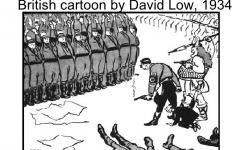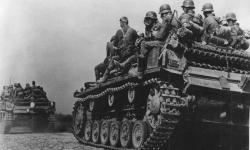The 20 July Bomb Plot
Key facts about the Bomb Plot
- The Bomb Plot was organised by elements within the WehrmachtThe unified German military from 1935-1945.The unified German military from 1935-1945. The unified German military from 1935-1945. (German army), particularly Claus von Stauffenberg
- The assassination of Hitler was to be followed by Operation ValkyrieOriginally a German plan to maintain order in the case of emergencies, it was modified by 20th July Bomb Plotters as part of a planned military coup.Originally a German plan to maintain order in the case of emergencies, it was modified by 20th July Bomb Plotters as part of a planned military coupA sudden, and often violent, illegal seizure of power from a government.. Originally a German plan to maintain order in the case of emergencies, it was modified by 20th July Bomb Plotters as part of a planned military coupA sudden, and often violent, illegal seizure of power from a government.. , where a military coup A sudden, and often violent, illegal seizure of power from a government. would take control of the country from the Nazis
- The conspirators wanted to show the world that not all Germans were bad. They were also unhappy with Hitler's leadership and military defeats.
- It failed due to luck and poor communication
- Almost 5,000 people were executed as a result and many committed suicide
People you need to know
- Friedrich Fromm - a German army general and head of the reserve army.
- Heinrich Himmler - Reichsführer of the SSShort for Schutzstaffel, it was a major Nazi paramilitary organisation which, among other things, was primarily responsible for the implementation of the Final Solution.Short for Schutzstaffel, it was a major Nazi paramilitaryA group organised along military lines. organisation which, among other things, was primarily responsible for the implementation of the Final Solution. Short for Schutzstaffel, it was a major Nazi paramilitaryA group organised along military lines. organisation which, among other things, was primarily responsible for the implementation of the Final Solution. and leading member of the Nazi Party.
- Adolf Hitler - leader of the Nazi Party and Führer of Germany.
- Erwin Rommel - celebrated German field marshal, popularly known as the Desert Fox.
- Claus von Stauffenberg - a German army officer and member of the traditional German nobilityThe highest hereditary stratum of the aristocracy, sitting immediately below the monarch in terms of blood and title; or the quality of being noble (virtuous, honourable, etc.) in character.The highest hereditary stratum of the aristocracyA generic term for the highest social class., sitting immediately below the monarchA king, queen, or emperor in terms of blood and title; or the quality of being noble (virtuous, honourable, etc.) in character. .
On 20 July 1944, Claus von Stauffenberg entered the conference room at the Wolf’s Lair in Rastenburg, East Prussia, carrying a briefcase with a primed bomb. Shortly after the start of the meeting, he received an urgent telephone call and excused himself, leaving the briefcase on the floor by Hitler. Somewhere between 10 and 20 minutes after the start of the conference, the bomb detonated, destroying the conference room and killing four people.
The bomb’s detonation, after some confusion, triggered the military coup codenamed Operation Valkyrie. Officers across Germany, believing the Führer dead, started taking control of military posts, including capturing SS and SDShort for Sicherheltsdienst, or Security Service, was the intelligence-gathering wing of the SS in Nazi Germany.Short for Sicherheltsdienst, or Security Service, was the intelligence-gathering wing of the SS in Nazi Germany. Short for Sicherheltsdienst, or Security Service, was the intelligence-gathering wing of the SS in Nazi Germany. units.
However, as rumours of Hitler’s survival spread throughout the afternoon, and Hitler himself recovered well enough to start making telephone calls at 7pm, the resistance started to crumble. Fromm, commander of the reserve army, switched allegiance and organised impromptu court martials, sentencing many of the leaders – including Stauffenberg – to death in an attempt to protect himself. This didn't do him any good: as soon as Himmler took control, Fromm was arrested and imprisoned. He too was shot on 12 March 1945. Himmler arrived in Berlin during the evening and quickly re-established control, beginning a wave of mass arrests. In the weeks following the failed plot, over 7,000 people were arrested, including those with only a loose connection to it as well as the plotters’ families (under the blood guilt laws). Four thousand, nine hundred and eighty were executed and many committed suicide. One of these was the war hero, Erwin Rommel, who was given the choice between suicide by cyanide or trial by the people’s court. He chose the former, thereby saving his family and staff, and received a full military funeral.
This didn't do him any good: as soon as Himmler took control, Fromm was arrested and imprisoned. He too was shot on 12 March 1945. Himmler arrived in Berlin during the evening and quickly re-established control, beginning a wave of mass arrests. In the weeks following the failed plot, over 7,000 people were arrested, including those with only a loose connection to it as well as the plotters’ families (under the blood guilt laws). Four thousand, nine hundred and eighty were executed and many committed suicide. One of these was the war hero, Erwin Rommel, who was given the choice between suicide by cyanide or trial by the people’s court. He chose the former, thereby saving his family and staff, and received a full military funeral.

The 1944 Bomb Plot has often been hailed as a ray of light, demonstrating that not all elements of German society supported the Nazis. And this was one of the reasons behind the plotters’ resistance: they wanted to show the world that Germany was not all bad. Undoubtedly many, including von Stauffenberg, found the brutality of the later regime (as well as the violence directed against Jews) abhorrent and were prompted by moral and ethical considerations to resist it. However, the need for the coup became pressing as Germany suffered more and more military setbacks. The real need to remove Hitler perhaps had more to do with a complete lack of trust in his military strategy and skill, as troops died in their thousands along the eastern front, and the Allies opened the western front during the D-Day landings. The only way Germany could succeed in the east was to make peace with the west, and the best way to do this was to remove Hitler.
Hitler, however, had a knack for survival. He survived six assassination attempts before – and arguably after – the July plot. The July plot itself, if not for a number of lucky coincidences, might have been more successful. The first was that due to hot weather the meeting was moved from Hitler’s bunker to a conference room, which allowed the walls to blow out during the explosion, rather than containing – and amplifying – the blast. The second was the failure to arm a second bomb Stauffenberg didn't have enough time to arm both bombs which would have doubled the magnitude of the blast and therefore would have had more chance of success. The last was the placement of von Stauffenberg’s briefcase, which had been by Hitler’s feet, but which got kicked behind a table leg after Stauffenberg left the room. Had the briefcase not been moved, the table would not have deflected the explosion away from Hitler, and he may have suffered more than a perforated eardrum.
Stauffenberg didn't have enough time to arm both bombs which would have doubled the magnitude of the blast and therefore would have had more chance of success. The last was the placement of von Stauffenberg’s briefcase, which had been by Hitler’s feet, but which got kicked behind a table leg after Stauffenberg left the room. Had the briefcase not been moved, the table would not have deflected the explosion away from Hitler, and he may have suffered more than a perforated eardrum.

What might have happened if the assassination attempt had been a success can only be guessed at. Some historians have argued that the coup would still have failed, that Göring would have stepped in and the regime would have continued, although perhaps without the same levels of brutality. The organisers of the Bomb Plot hoped to come to peaceful terms with the west, but continue the war against the east, although it is unlikely that the Allies, gaining ground in the west, would agree to this. It is probable, then, that the war would have continued. What is more certain is that it would have been quicker and less brutal for all if the plot had succeeded.
Things to think about
- What were the real reasons for the Bomb Plot?
- How much opposition was there to Hitler?
- Did Hitler have a talent for survival?
- Could the plot ever have succeeded?
- What would have been the outcome of a successful plot?
Things to do
- Research what other plots and assassination attempts there were against Hitler. Are there any themes in common, and what do they tell us about Hitler and those who opposed him?
Further reading
The best person to read to gain an understanding of Nazi Germany and Hitler is Ian Kershaw. He has written extensively on the Third ReichLiterally meaning the third realm or empire. It is the name used to describe Nazi Germany, from 1933 until 1945.Literally meaning the third realm or empire. It is the English name used to describe Nazi Germany, from 1933 until 1945. Literally meaning the third realm or empire. It is the English name used to describe Nazi Germany, from 1933 until 1945. , but one (or two) of his best is the biography of Hitler that was first published in two parts and has now been abridged into one volume.
- Log in to post comments






